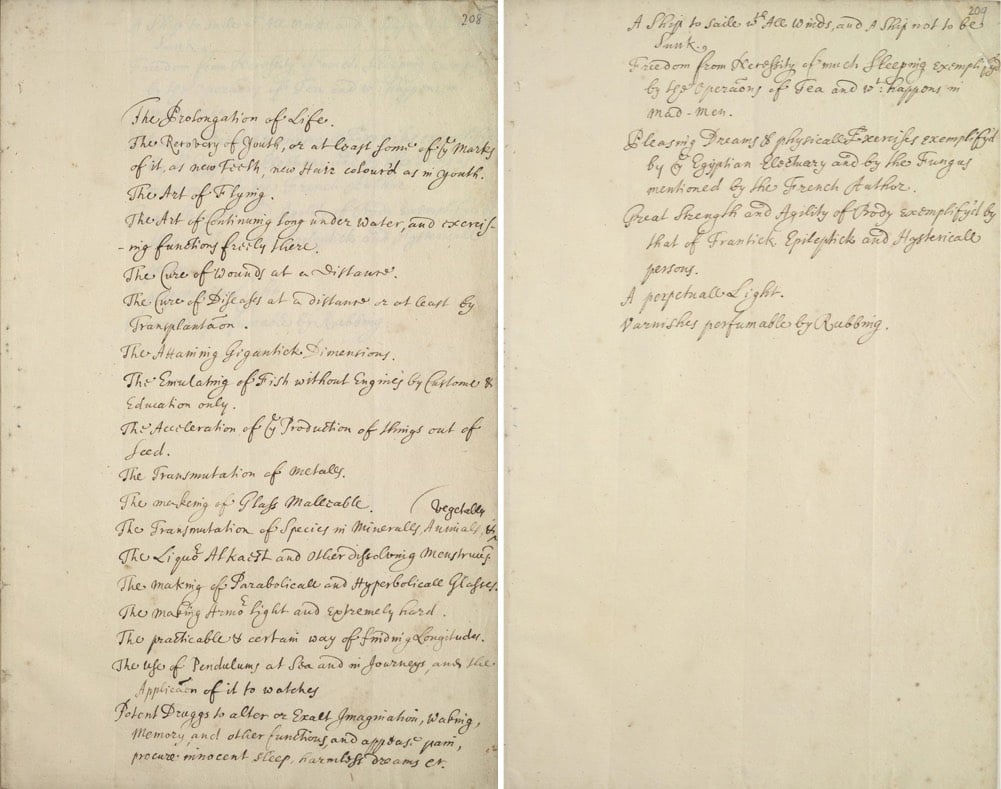A wishlist of scientific breakthroughs by Robert Boyle

17th-century scientist Robert Boyle, one of the world’s first chemists and creator of Boyle’s Law, wrote out a list of problems he hoped could be solved through science. Since the list was written more than 300 years ago, almost everything on it has been discovered, invented, or otherwise figured out in some fashion. Here are several of the items from Boyle’s list (in bold) and the corresponding scientific advances that have followed:
The Prolongation of Life. English life expectancy in the 17th century was only 35 years or so (due mainly to infant and child mortality). The world average in 2014 was 71.5 years.
The Art of Flying. The Wright Brothers conducted their first flight in 1903 and now air travel is as routine as riding in a horse-drawn carriage in Boyle’s time.
The Art of Continuing long under water, and exercising functions freely there. Scuba gear was in use by the end of the 19th century and some contemporary divers have remained underwater for more than two days.
The Cure of Diseases at a distance or at least by Transplantation. Not quite sure exactly what Boyle meant by this, but human organ transplants started happening around the turn of the 20th century. X-rays, MRI machines, and ultrasound all peer inside the body for disease from a distance. Also, doctors are now able to diagnose many conditions via video chat.
The Attaining Gigantick Dimensions. I’m assuming Boyle meant humans somehow transforming themselves into 20-foot-tall giants and not the obesity that has come with our relative affluence and availability of cheap food. Still, the average human is taller by 4 inches than 150 years ago because of improved nutrition. Factory-farmed chickens have quadrupled in size since the 1950s. And if Boyle paid a visit to the Burj Khalifa or the Mall of America, he would surely agree they are Gigantick.
The Acceleration of the Production of things out of Seed. To use just one example out of probably thousands, some varieties of tomato take just 50 days from planting to harvest. See also selective breeding, GMOs, hydroponics, greenhouses, etc. (P.S. in Boyle’s time, tomatoes were suspected to be poisonous.)
The makeing of Glass Malleable. Transparent plastics were first developed in the 19th century and perfected in the 20th century.
The making of Parabolicall and Hyperbolicall Glasses. The first high quality non-spherical lenses were made during Boyle’s lifetime, but all he’d need is a quick peek at a pair of Warby Parkers to see how much the technology has advanced since then, to say nothing of the mirrors on the Giant Magellan Telescope.
The making Armor light and extremely hard. Bulletproof armor was known in Boyle’s time, but the introduction of Kevlar vests in the 1970s made them truly light and strong.
The practicable and certain way of finding Longitudes. When pushed to its limits, GPS is accurate in determining your location on Earth to within 11 millimeters.
Potent Druggs to alter or Exalt Imagination, Waking, Memory, and other functions, and appease pain, procure innocent sleep, harmless dreams, etc. Dude, we have so many Potent Druggs now, it’s not even funny. According to a 2016 report, the global pharmaceutical market will reach $1.12 trillion.
A perpetuall Light. It’s not exactly perpetual, but the electric lightbulb was invented in the 19th century and the longest-lasting bulb has been working for at least 116 years.
Varnishes perfumable by Rubbing. Scratch and sniff was invented by 3M in 1965.
(via bb)





Stay Connected